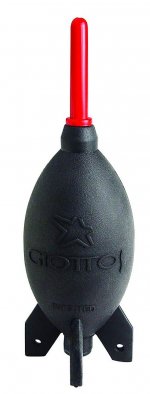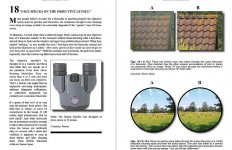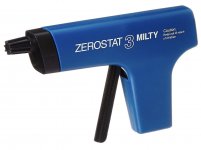The Clean Binocular
Short answer:
Get a GIOTTOS Rocket Dust Blower Size AA1900 (any other China- made dust blower, such as used in some cleaning kits is useless). Blow it off.
Long answer:
Optical companies know that most customers (e.g hunters) are not willed or able to properly clean a binocular/ spotting scope or any other product. So some offer little things/gizmos (e.g. cloths, blowers, brushes) to allow for easy "cleaning" that is better than using a piece of rough kitchen paper. Or the tip of the tie. As demonstrated here:
https://www.youtube.com/watch?v=yii7G3p5Sic (at 1:58).

Also, it is easy to over"clean"a bin etc. by affecting the outer hard coated anti-reflex-layers of optical surfaces with those microfiber cleaning cloths supplied also by the big three names. They are dangerous IMHO or make it even worse than before. Why? Because a normal/ untrained person usually applies way too much pressure on the lens surfaces also when using the cloth.
The cleaning depends on whether the lens surface is treated with a Lotus-effect-layer such as LOTUTEC, SWAROCLEAN or AQUADURA or not, like on an older ZEISS DIALYT 10x40 T*P B GA.
Assume that we are cleaning such a treated outer lens surface:
If we are just talking about some dust particles (sand grains, pollen, skin particles, soil particles etc.) the traditional way is to use that famous soft brush. I am always warning to use the brush/ I am against it totally, as it will often apply oily/ greasy residues from former "cleanings" onto the lens surface. At worst it can scratch the lens surface too. Just blow the loose particles off with the LARGE GIOTTOS AA 1900 dust blower. Also a few and occasional rain drops will disappear now.
If some small residues from liquids (e.g. evaporated water droplets) are on the objective or eyepiece surface and as such that they will disturb the image quality the method I use is as follows:
First we have to make our own cotton swap cleaners: Get a wooden stick. Bamboo sticks (as used for barbecue), elder wood sticks (available from handicraft work retail shops; they can be pointed with an unused pencil sharpener). Have a small volume of tap water aside. Use KERMA OPHTALMOLOGICAL COTTON WOOL only (PZN-04751039, see here:
https://kerma.de/wp-content/uploads/2016/10/Augenwatte.pdf). Wet the tip of the wooden stick so that the cotton fibers will attach more easily. Form a cotton swap as shown here: https://applications.zeiss.com/C125792900358A3F/0/3C1DAE76330E42F7C12579EC0028F56B/$FILE/50-1-0025_the_clean_microscope_e.pdf). Apply a very generous amount of cotton stepwise on the wooden stick. Make sure that the wooden tip of the stick is safely and fully covered by generous amounts of cotton fibers. Otherwise the lens will get scratched easily.
Q-Tips or readily made up cotton swaps for medical purposes are not recommended (treated with chemicals or having the wrong cotton fiber length for optical cleaning, too little amounts of cotton etc.). The expensive microfiber cleaning tools from e.g. TEXWIPE (albeit resulting in perfect cleaning results in the right hands) are also not suitable here as most people will apply too much force with them. Over long periods of time that will also affect the coatings. Bins have a long use time (20-30 years or longer).
Now VERY CAREFULLY ONLY (!!!) breathe on the glass surface. As a result you have a very even thin film of distilled water produced on the glass surface. Without any pressure (!!!) make circular movements with the cotton stick from center outwards on the lens surface. Replace the cotton and repeat a few times. It also helps to grip the bin with the other hand and rotate it during the cleaning movement slightly.
The inspection of the lens surface with an office desk lamp will tell you when the cleaning was to your like. Also the cleaning I do under such a lamp illumination.
Residues of finger prints are first removed with diluted dish washing liquid (1 drop, e.g. PRIL, FAIRY ULTRA (only the clear versions of such liquids) in 50 ml of warm tap water).
Residues of more greasy contamination have to be removed with organic liquids or sometimes strong organic solvents, but this would be another topic to talk about.
If the image looks good, don´t clean too much!
A strong and direct LED illumination into the optics will always reveal some small internal dust, coating imperfections or tiny air bubbles melted into the often very expensive glass material in bins and spotting scopes, which are unavoidable and do not affect image quality at all (except on optical planes conjugated to the image plane) if small in size and number.
"Optics are made to look through them, not at them", Ernst Abbe already said.
All the best
Michael









